reeb
New member
- Oct 23, 2017
- 568
- 85
- Parrots
- Berry (♀ Cockatiel) hatched June 2017
Opal (♂ Budgie) hatched 13 August 2017
Pearl (♀ Budgie) hatched 15 August 2017
+ an aviary of 16 other budgies! all hatched 2014-2017
Hi everyone,
So I have 10 show budgies, and I love how they look and I really enjoy breeding with them. However, I have never actually entered them into competitions (and I don't plan to). I went to my first show this weekend to check it out, and while I really enjoyed seeing some beautiful birds I could see a lot of distress as well. Nevertheless, I have included some pictures from the show at the end of this post.
I decided to do some more research on showing budgies, and I spent a bit of time on the Budgerigar Society of South Africa website, as well as on the international Budgerigar Society website and the World Budgerigar website. I then came across this absolutely despicable and downright cruel method for preparing show budgies for shows. I think this is a general method that a lot of people do use (both here and elsewhere in the world).
Before I post the article, there are certain show requirements that I would like to mention. These include not being mid-molt during the show (your bird will be automatically disqualified). There are specific spotting patterns on the cheeks that must meet certain criteria. Obviously the colours need to match the colour mutation standards. It's all really silly and cosmetic, and I just think it's ridiculous. Here is a link to some of these standards.
Anyway, here is the article I mentioned (I have copy pasted it for convenience sake, and I have emboldened some of the scariest and most cruel sections):
"Start selecting your show team three months before your first show. Start looking for the good show prospects. If you see one, catch it up and put it into a smaller stock cage. This will help the birds get used to a smaller cage. I put several birds into each cage. Make sure you don't crowd them, though. After the birds have been in the smaller cages for a few days, you can start putting them into the show cages for an hour or so at a time. Each time you put a bird into the show cage, leave it a little longer. This will let the bird gradually get used to the cage. The last week or two before the show, I will leave the bird in the show cage for about 24 hours. Make sure you always have plenty of food and water in the show cage when you do this.
After the birds have been in the show cage a few times and have settled down, start training them with a stick. I usually start training the birds by racking the stick across the bars occasionally until the birds get used to this and will stay steady when you do it. To train them to stay on the perch, gently push the stick against their legs. They will step onto the stick, and you can lift them up onto the perch. After a while they will jump up onto the perch when you put the stick through the bars or just barely touch their legs. If you have a bird that leans over the perch, or won't stand up, you can try tapping on the front rail. Many times this will make them straighten up and stand up. After a while they will get the idea. If tapping doesn't work, you can try gently nudging them on the chest. Remember always be gentle and patient. If you feel yourself losing patience, put the birds away and try another time.
Two months before the first show, I pull the two main long tail feathers on each bird. Also check the primary wing flight feathers. If any are broken or frayed, pull them. The best way to pull feathers is to firmly grasp each one and pull steadily.
Two months before the show I start spraying my birds three times a week. If the weather is warm enough, I take the birds outside and spray them with the garden hose fitted with a flower nozzle. I soak the birds thoroughly and let them dry. If it is too cold spray them inside but lighter. One month before the show I increase the spraying to a daily basis. I stop spraying three days before the show.
One of the hardest things for people to learn is how to remove the excess spots from the mask. The way I learned was to look at pictures of show birds to see how the spots were supposed to look. I practised on the birds that I wasn't going to show. I finally learned to spot my birds. You leave one spot under each cheek patch and four on the mask. The four on the mask should be the same size with a symmetrical look.
The second most important thing next to your birds is your show cages. Give your show cages some attention. If they need repair, then do it now. Give them a good cleaning. After you get them clean, check to see if they need repainting. Remember a budgie will look much better in a clean bright show cage.
When you go to the show, take a well conditioned and prepared budgie in a clean bright show cage. Then if your bird is a good bird, and shows well, your bird will have the best chance of taking an award. If your bird doesn't do well don't let it be your fault! Good luck on the show season."
Am I the only one that thinks that this is straight-up animal cruelty?!
Here are some pictures from the show:
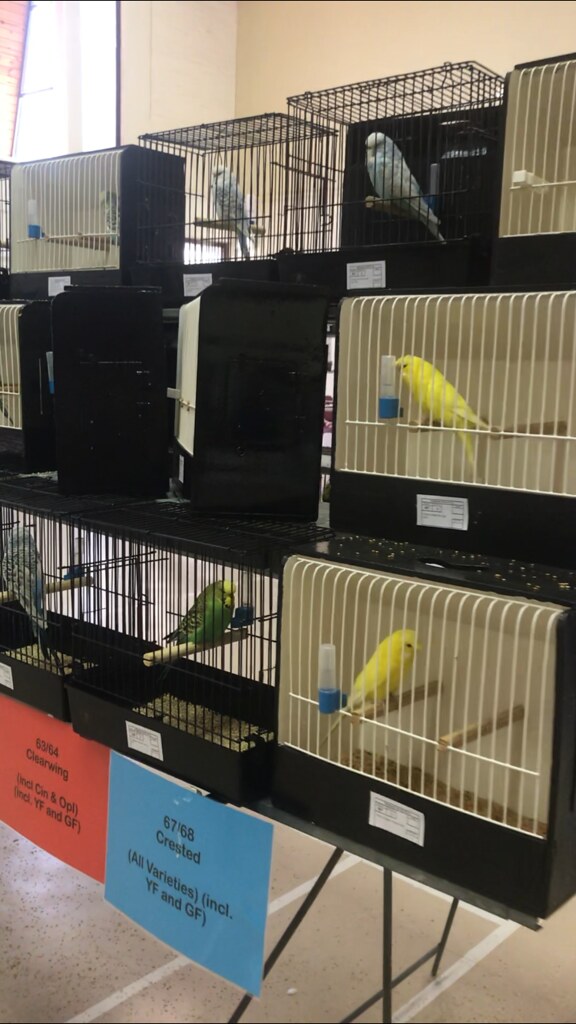
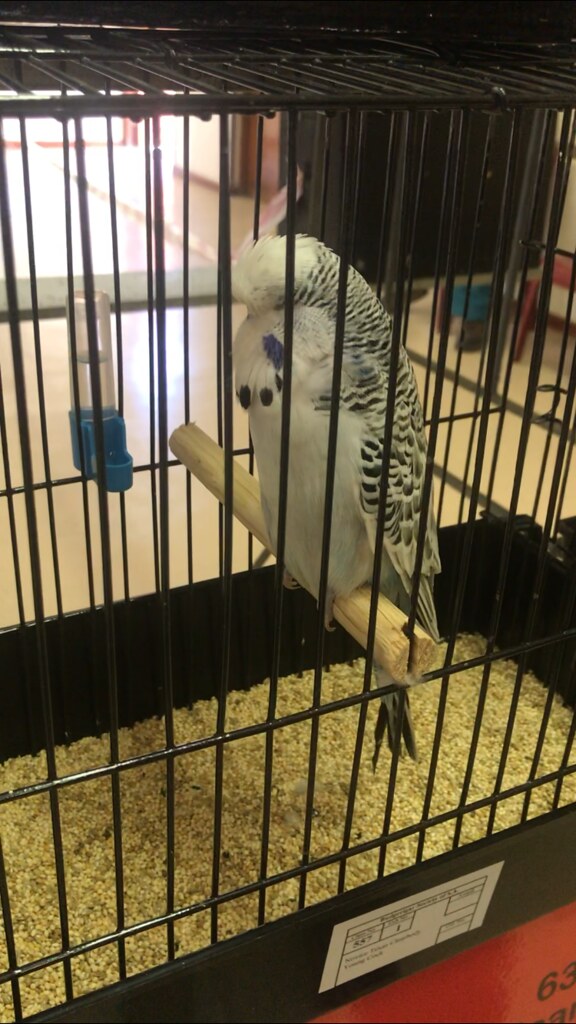
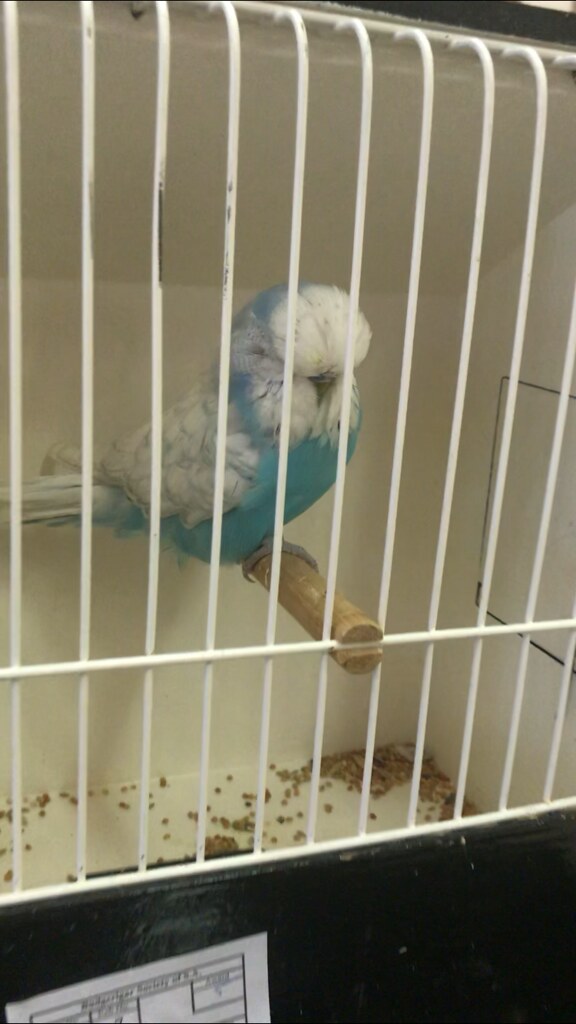
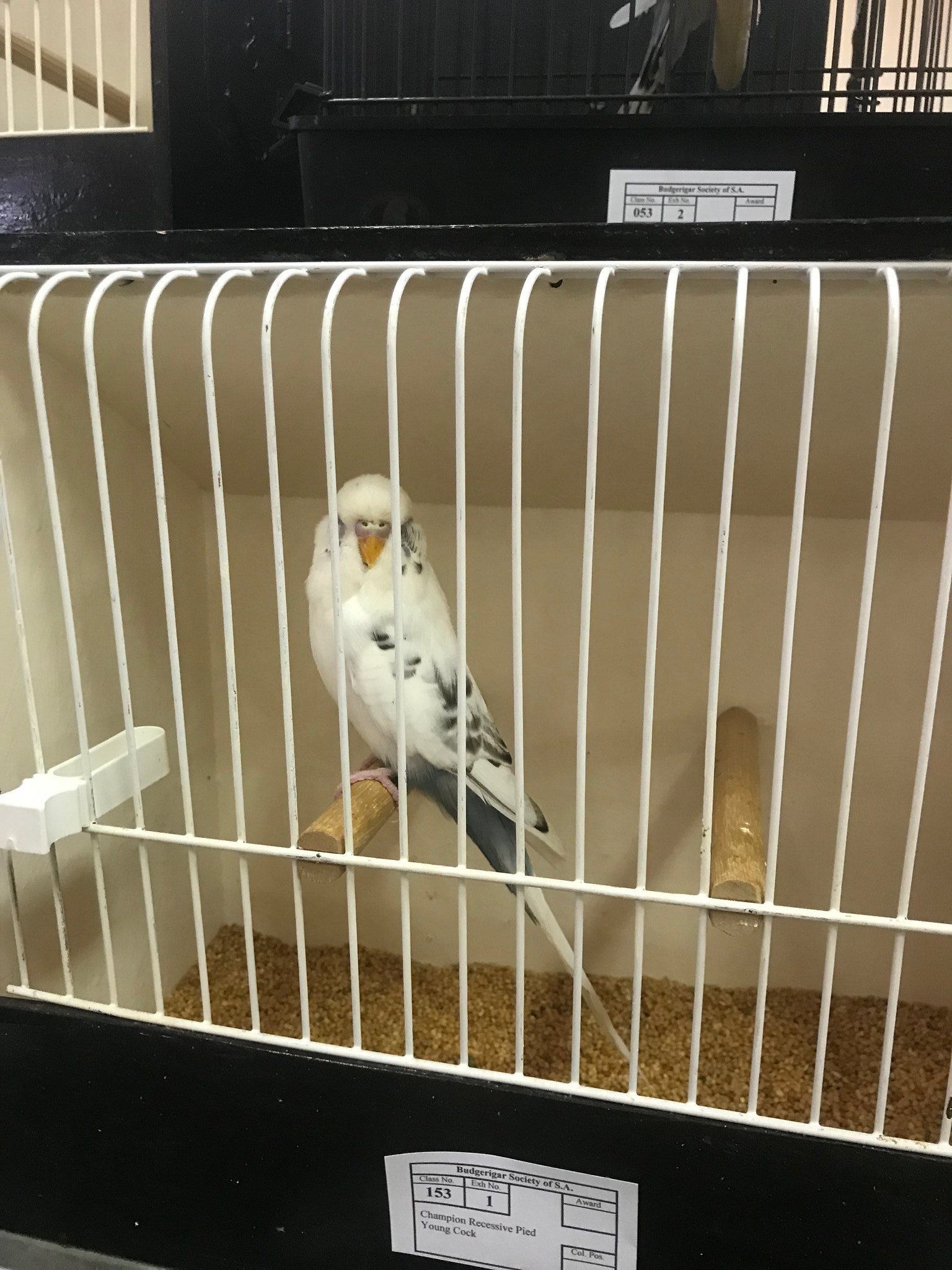
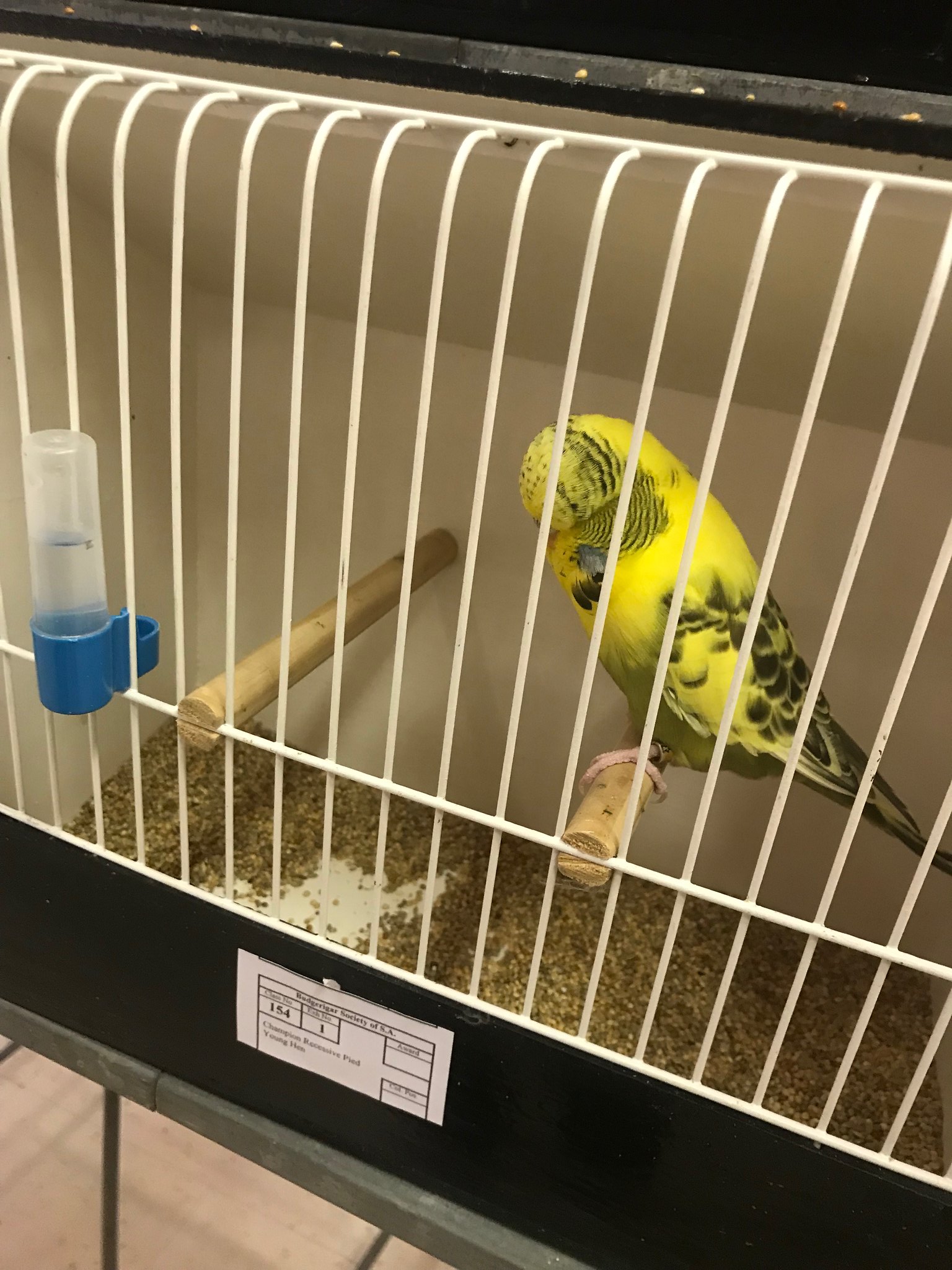
So I have 10 show budgies, and I love how they look and I really enjoy breeding with them. However, I have never actually entered them into competitions (and I don't plan to). I went to my first show this weekend to check it out, and while I really enjoyed seeing some beautiful birds I could see a lot of distress as well. Nevertheless, I have included some pictures from the show at the end of this post.
I decided to do some more research on showing budgies, and I spent a bit of time on the Budgerigar Society of South Africa website, as well as on the international Budgerigar Society website and the World Budgerigar website. I then came across this absolutely despicable and downright cruel method for preparing show budgies for shows. I think this is a general method that a lot of people do use (both here and elsewhere in the world).
Before I post the article, there are certain show requirements that I would like to mention. These include not being mid-molt during the show (your bird will be automatically disqualified). There are specific spotting patterns on the cheeks that must meet certain criteria. Obviously the colours need to match the colour mutation standards. It's all really silly and cosmetic, and I just think it's ridiculous. Here is a link to some of these standards.
Anyway, here is the article I mentioned (I have copy pasted it for convenience sake, and I have emboldened some of the scariest and most cruel sections):
"Start selecting your show team three months before your first show. Start looking for the good show prospects. If you see one, catch it up and put it into a smaller stock cage. This will help the birds get used to a smaller cage. I put several birds into each cage. Make sure you don't crowd them, though. After the birds have been in the smaller cages for a few days, you can start putting them into the show cages for an hour or so at a time. Each time you put a bird into the show cage, leave it a little longer. This will let the bird gradually get used to the cage. The last week or two before the show, I will leave the bird in the show cage for about 24 hours. Make sure you always have plenty of food and water in the show cage when you do this.
After the birds have been in the show cage a few times and have settled down, start training them with a stick. I usually start training the birds by racking the stick across the bars occasionally until the birds get used to this and will stay steady when you do it. To train them to stay on the perch, gently push the stick against their legs. They will step onto the stick, and you can lift them up onto the perch. After a while they will jump up onto the perch when you put the stick through the bars or just barely touch their legs. If you have a bird that leans over the perch, or won't stand up, you can try tapping on the front rail. Many times this will make them straighten up and stand up. After a while they will get the idea. If tapping doesn't work, you can try gently nudging them on the chest. Remember always be gentle and patient. If you feel yourself losing patience, put the birds away and try another time.
Two months before the first show, I pull the two main long tail feathers on each bird. Also check the primary wing flight feathers. If any are broken or frayed, pull them. The best way to pull feathers is to firmly grasp each one and pull steadily.
Two months before the show I start spraying my birds three times a week. If the weather is warm enough, I take the birds outside and spray them with the garden hose fitted with a flower nozzle. I soak the birds thoroughly and let them dry. If it is too cold spray them inside but lighter. One month before the show I increase the spraying to a daily basis. I stop spraying three days before the show.
One of the hardest things for people to learn is how to remove the excess spots from the mask. The way I learned was to look at pictures of show birds to see how the spots were supposed to look. I practised on the birds that I wasn't going to show. I finally learned to spot my birds. You leave one spot under each cheek patch and four on the mask. The four on the mask should be the same size with a symmetrical look.
The second most important thing next to your birds is your show cages. Give your show cages some attention. If they need repair, then do it now. Give them a good cleaning. After you get them clean, check to see if they need repainting. Remember a budgie will look much better in a clean bright show cage.
When you go to the show, take a well conditioned and prepared budgie in a clean bright show cage. Then if your bird is a good bird, and shows well, your bird will have the best chance of taking an award. If your bird doesn't do well don't let it be your fault! Good luck on the show season."
Am I the only one that thinks that this is straight-up animal cruelty?!
Here are some pictures from the show:






